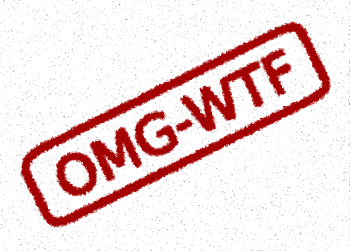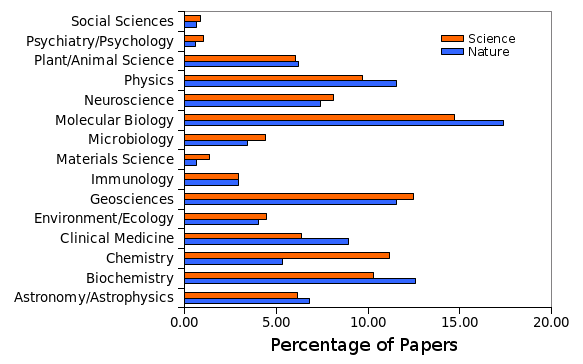Rejected!
October 19, 2012
In a
previous article (Peer Review, October 8, 2012), I wrote how the criticism of
scientific papers does not always detract from their popularity. This was discovered in an analysis of published comments, sometimes seen as
letters to the editor, in many
journals.[1]
Authors are usually disturbed by negative technical comments, but commented papers were found to have
citation rates much higher than those of non-commented articles, and they were the most cited papers in the journals in which they are published.[1]
Well, if bad publicity such as this actually has an affect opposite to what's expected, what happens when the commentary is even more severe? This would be the commentary by a paper's
referee that results in a paper's being rejected by a journal.
If the cause of the rejection is a critical error in either an
experiment or a
calculation, then the authors should be happy that the error was found. In that case, the paper is destined for the
circular file. In many cases, however, there's no bad
science, it's just that the paper doesn't meet the journal's lofty standards. The authors usually just resubmit to a lesser journal; that is, journals with a lower
impact factor.[2]

Rejection rubber stamp for the Internet age.
Rejections of submitted scientific manuscripts are typically more reasoned and less brutal, but don't ask the author's opinion of that!
(Image by author, rendered using Inkscape and GIMP)
There are intermediate cases in which the referee decides that more, or better controlled, experiments are in order. Many
scientists will take that criticism to heart and make the necessary improvements. In such cases, the referee serves as a
mentor, and having a knowledgeable mentor is always worthwhile. After such improvements, the revised paper is of much higher
quality.
An international team of scientists from the
Institut Sophia Agrobiotech (France),
McGill University (Canada) and the
University of Hawaii examined the ultimate fate of rejected
bioscience papers.[3-5] The journals, of course, are not willing to release details of the selection process for specific papers, so the study authors needed to appeal to the authors of the bioscience papers for information.
As you can imagine, this is quite a task, only possible now because of
computer databases and automatic
email messaging. The computer system of the research team sent an email
questionnaire to the corresponding author of 215,000 articles. They received data for 37% of their queries.[3]
The study was an analysis of the publication history of 80,748 papers published in 923 bioscience journals between 2006 and 2008.[4] The first, unsurprising finding was that resubmitted papers gravitated down the prestige chain to lower impact journals.[4] One other finding, at first surprising, but easily explained, is that high impact journals such as
Science and
Nature publish a higher percentage of resubmitted papers than lesser journals.[5]
The explanation for this is is simply that there are many more lower impact journals to which a paper may be submitted. Furthermore, the lower impact journals accept more papers, so their baseline for the percentage calculation is larger.[4] Authors will assess their chances of publication with various journals, both low and high impact, and they will submit only when they believe their chances for acceptance are high. That's why 75% of published papers are published in the journals to which they're first submitted.[4-5]

How popular is your field of science? This graph shows the percentage of papers in Science and Nature in each field for which there were more than fifty during the years 2000-2010. (Data from Sci-Bytes, ref. 8).[8)]
For those authors too happy about being accepted by that first journal, articles rejected by one journal, but published by another, had significantly more citations that those papers accepted at the first submission.[3,5] As an
interdisciplinarian myself, I was saddened to find that the study showed that interdisciplinary work had lower citation rates, probably because the journals that publish such work have a low impact factor.[3]
Papers resubmitted immediately after the first rejection are typically unchanged, and these go to the low impact journals. However, if resubmittal occurs after an improvement phase that could extend to several years, the published paper has a higher citation rate than the average paper in the journal in which it's eventually published.[4,6]
Lead author of the study,
Vincent Calcagno, had this summary of his paper's most important conclusion.
"We think the most likely explanation is that inputs from editors and peer reviewers, and the greater amount of time spent working on resubmissions, makes papers better and improves the citation impact of the final product."[3]
Michael Schreiber, a professor at the
Institut für Physik,
Technische Universität Chemnitz (Germany), who has published quite a few papers on citation analysis,[7] is quoted in Nature as saying that editors might use this new data in a prospective manner.
"Reject more, because more rejections improve quality."[4]
References:
- Filippo Radicchi, "In science "there is no bad publicity": Papers criticized in technical comments have high scientific impact," arXiv Preprint Server, September 22, 2012.
- There was actually a journal with the word, "less," in its title. That's the Journal of the Less Common Metals, which was merged into the
Journal of Alloys and Compounds in 1992.
- Study of research-paper submissions sheds new light, McGill University Press Release, October 12, 2012.
- Philip Ball, "Rejection improves eventual impact of manuscripts," Nature News, October 11, 2012.
- V. Calcagno, E. Demoinet, K. Gollner, L. Guidi, D. Ruths and C. de Mazancourt, "Flows of Research Manuscripts Among Scientific Journals Reveal Hidden Submission Patterns," Science, Published Online, October 11, 2012, DOI: 10.1126/science.1227833.
- L. Bornmann and H.-D. Daniel, Angew. Chem. Int. Edition, vol. 47, no. 38 (September 8, 2008), pp. 7173-7178.
- Papers by Michael Schreiber on the arXiv Preprint Server.
- Ranks for Nature and Science by Citation Impact, 2000-2010, Sci-Bytes.
Permanent Link to this article
Linked Keywords: Scientific literature; scientific paper; letters to the editor; scientific journal; author; citation; peer review; referee; experiment; calculation; circular file; science; impact factor; rubber stamp; Information Age; Internet age; Inkscape; GIMP; scientist; mentor; Zen and the Art of Motorcycle Maintenance; quality; Institut Sophia Agrobiotech (France); McGill University (Canada); University of Hawaii; bioscience; computer database; email; questionnaire; Science; Nature; Sci-Bytes; interdisciplinarity; interdisciplinarian; Vincent Calcagno; Michael Schreiber; Institut für Physik; Technische Universität Chemnitz (Germany).